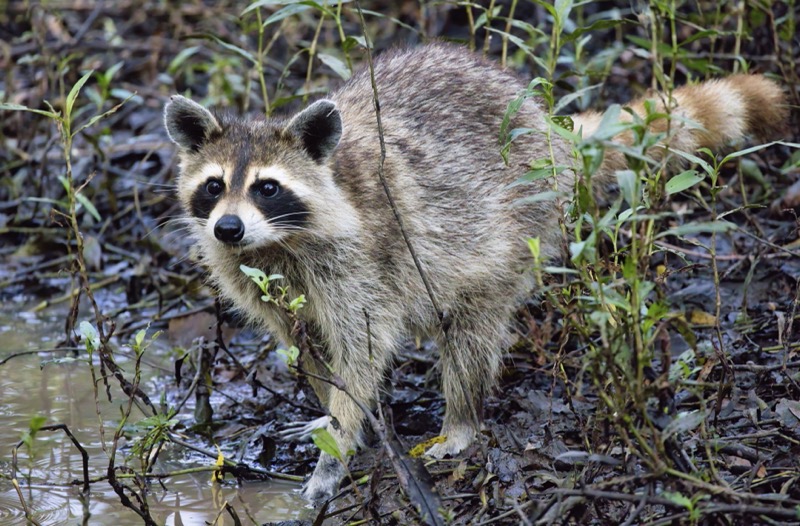At Sequoyah National Wildlife Refuge in Oklahoma, I photographed a raccoon with a cinnamon-colored tail. I have photographed cinnamon-colored raccoons before (Cinnamon Raccoon In Oklahoma), but this was my first time seeing one with such a distinct tail.

A Unique Sighting
I found this raccoon near the curve west of the 4-way intersection in the refuge. It wasn’t alone—a young raccoon was with it, closely following the adult, likely learning how to navigate its environment. Observing their bond highlighted the importance of family connections in the animal world.
The young raccoon mimicked many of the adult’s movements, emphasizing the importance of family groups for survival. Observing them as they moved through the underbrush, stopping to rest or investigate food sources, underscored the role of family in learning vital survival skills.
Photographing the Moment
To photograph them, I used my camera on a bean bag over the open window of my truck. This setup provided stability while keeping me out of sight, crucial for capturing authentic behavior. The early morning light was challenging, requiring a high ISO setting and a shutter speed of 1/800 to freeze their movement effectively. The Canon EOS R5 handled the low light well, allowing me to capture detailed images of the raccoons interacting.
As the sun rose, the natural backlighting highlighted the texture of their fur, especially the distinctive cinnamon-colored tail. Moments like these—the interplay of light and shadow—make the effort worth
The Fascination of Cinnamon Raccoons
Cinnamon raccoons are rare, and seeing one with a cinnamon-colored tail is even more unusual. These sightings highlight the genetic diversity within raccoon populations, which is crucial for adaptability and survival. The cinnamon color is likely due to a recessive gene, emphasizing the importance of preserving diverse habitats to support such unique individuals.
Sequoyah National Wildlife Refuge provides an ideal environment for observing such variations. Its mix of wetlands, woodlands, and open areas supports diverse wildlife. On this day, the cinnamon-tailed raccoon was the highlight, but I also saw deer browsing in the distance and birds calling from the treetops. The refuge’s rich habitat makes each visit unique and rewarding.
Gear Used
- Camera: Canon EOS R5
- Lens: EF 800 mm f/11
Technical Details
- Location: Sequoyah National Wildlife Refuge, Oklahoma
- Date: July 3, 2021, 9:00 AM
- Aperture: f/11
- Shutter Speed: 1/800
- ISO: 1600 (Auto)
- Exposure Compensation: 0
- Focal Length: 800 mm
I enjoy photographing wildlife at Sequoyah National Wildlife Refuge because of the variety of animals and behaviors I encounter. Encounters like this one with the cinnamon-tailed raccoon remind me why I keep coming back. It’s not just about the photos; it’s about the stories behind them and the glimpse into the lives of these creatures. The refuge offers the unexpected, and each visit brings something new to appreciate.
In addition to the raccoons, I observed egrets wading in the marsh and a red-shouldered hawk perched high on a tree branch. Each species contributes to the intricate web of life within the refuge. Experiencing this range of behaviors in a single visit is a privilege. Wildlife photography is about patience and respect for nature, and Sequoyah offers endless opportunities for both.
Conservation of places like Sequoyah is vital for preserving not only the animals but also the human experiences that come from observing them. Protected areas like this allow wildlife to flourish and provide photographers like me the chance to capture and share their stories.
